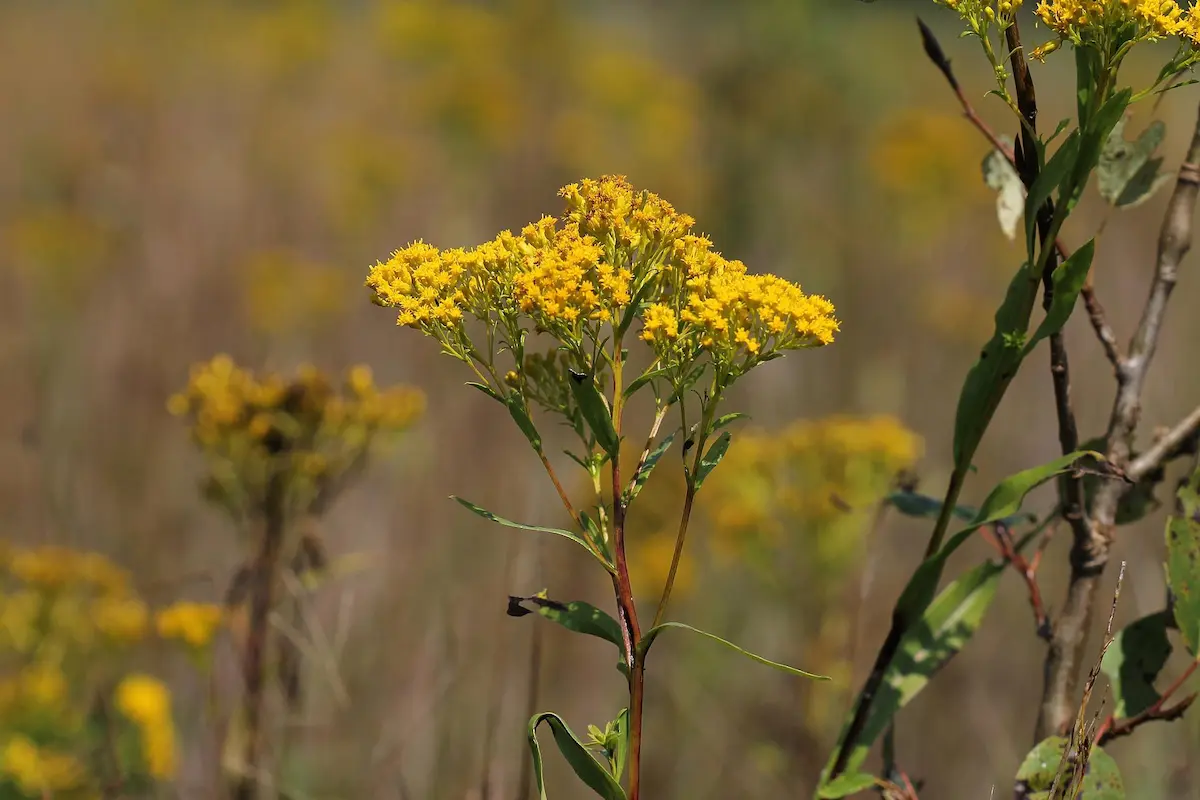Ohio Goldenrod

Ohio Goldenrod (Solidago ohioensis) has a compact form that belies its large, exuberant floral display late in the season. It has flat-topped clusters of vivid yellow flowers, while lance-like leaves form a basal rosette. Seeds are produced with fluff, which is dispersed through the wind. Native Americans and early settlers used this plant to make a strong yellow dye from the flowers.
Goldenrods are frequently blamed for hay fever, an allergic response to pollen carried by the wind. They do not, however, have pollen carried by the wind. Instead, bees, butterflies, and other pollinators transport pollen from one bloom to the next.
Quick Growing Guide
Botanical Name: Solidago ohioense
En français: Verge d’or de l’ohio
See More Plants in this Botanical Family:
Colour:
Sun / Shade:
Watering:
Soil:
Height:
Width:
Pollinators:
Care:
Pollinators
Ohio Goldenrod’s lengthy bloom period attracts a great number of native bees and butterflies. It also attracts a variety of birds, including goldfinches, chickadees, and wrens.
Appearance of Ohio Goldenrod
A blooming, erect perennial with a height of 3 to 4 feet (about 1 meter), Solidago ohioensis. These goldenrod plants have flat, blunt-tipped lance-shaped leaves. The leaves at the base of the plant have long stalks, are larger than the higher leaves, and are mostly hairless.
On stems that are branching at the top, this wildflower yields yellow flower heads with six to eight short rays that unfold. Many people mistakenly believe that this plant causes hay fever, but in reality, it simply blooms at the same time as ragweed, which is the true allergen, in the late summer and early fall.
In contrast to its late-season huge, flamboyant floral show, Ohio Goldenrod has a compact shape. The magnificent foliage extends out from the base with thick, lance-shaped leaves. It works well in damp clay and prospers in healthy garden soil.
Its Latin genus name, Solidago, which alludes to its therapeutic qualities, means “to make whole.” Early settlers and Native Americans alike used Ohio goldenrod for medicine and to make a vivid yellow dye.
How to Grow Ohio Goldenrod
To germinate, the Ohio goldenrod needs to be stratified for four weeks. In the late fall, direct sow seeds, gently pressing the seeds into the ground. When planting in the spring, combine the seeds with wet sand and store them in the fridge for 60 days. Keep the soil moist after sowing until germination.
Because they are native plants, Ohio goldenrod care is as simple as ensuring that the plants stay moist as they age. However, they won’t self-sow vigorously. Bees and butterflies are drawn to this shrub, which also produces beautiful cut flowers.
The blossoms turn yellow to white as the seeds mature after they have bloomed. Snip the heads before they become entirely white and dry if you want to save the seeds. Remove the seed from the stem and remove as much of the plant as possible. The seeds should be kept in a cool, dry area.
The Characteristics of Ohio Goldenrod
The goldenrod in North America is home to hundreds of insects, including butterflies, spiders, praying mantises, bees, and many other species. The appearance of the Ohio goldenrod, which grows and glows in the undersides of hardwood trees, in roadside ditches, in meadows, and gardens, is thought to notify the start of autumn.
Ohio Goldenrods are frequently wrongly held responsible for hay fever, an allergic reaction to pollen carried by the wind. However, they lack wind-borne pollen, as do the majority of natural wildflowers. Instead, bees, butterflies, and other pollinators carry the pollen from bloom to bloom.
Ohio goldenrod attracts many butterflies, bees, flies, and other insects as changeable pollinator feeders. Birds tend to search for these insects near Ohio goldenrod gardens. So, you might regularly see birds flying over the area with Ohio goldenrod.
Other Goldenrods
Discover the differences among many these goldenrods.
- Grass Leaved Goldenrod
- Early Goldenrod
- Stiff Goldenrod
- Squarrose Goldenrod
- Rough-stemmed Goldenrod
- Blue Stemmed Goldenrod
- Zigzag Goldenrod
They each have their own uniqueness.
